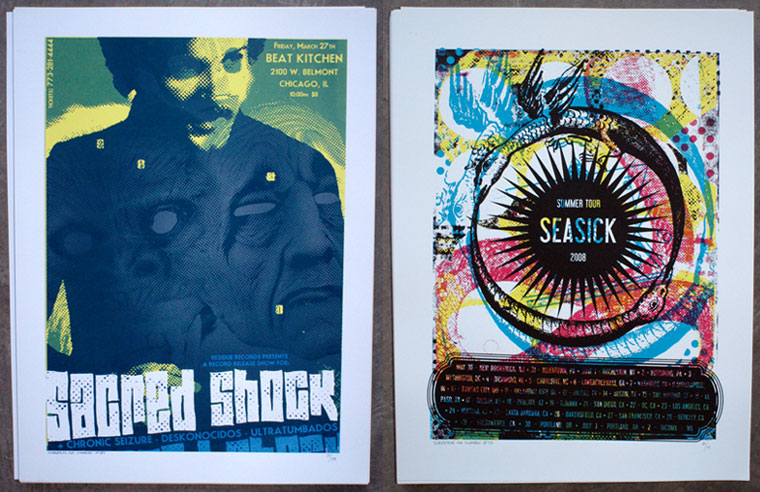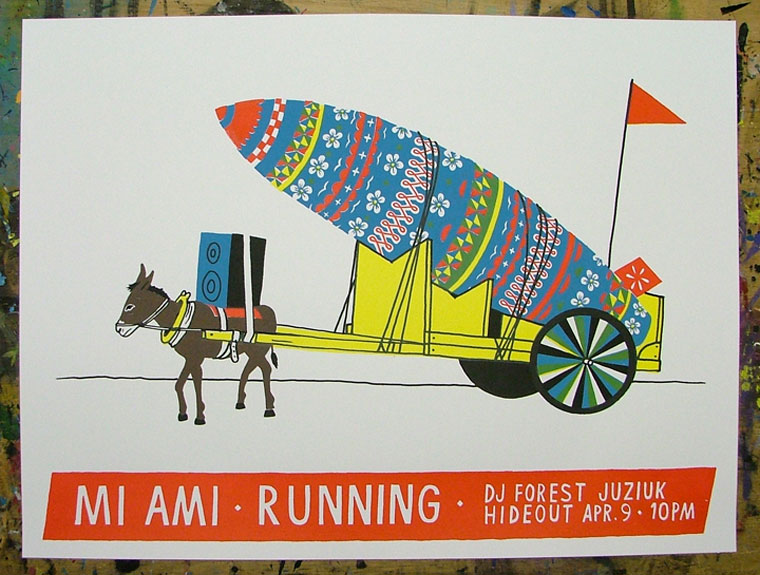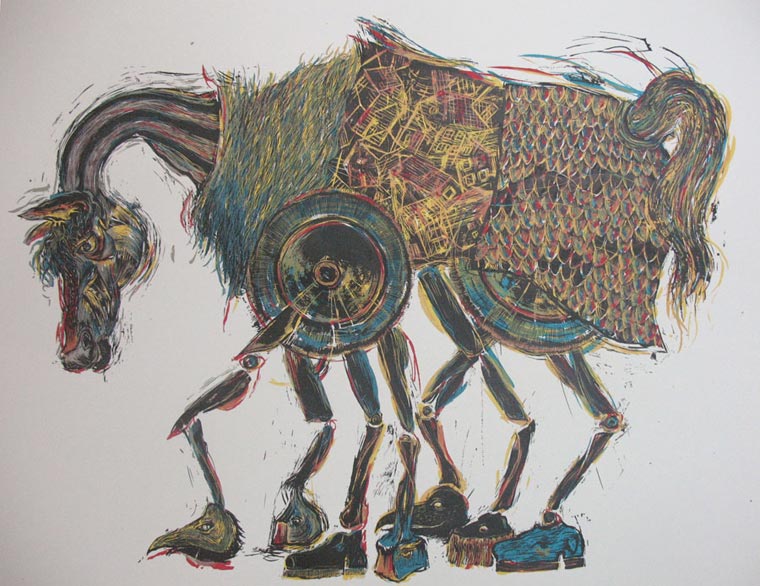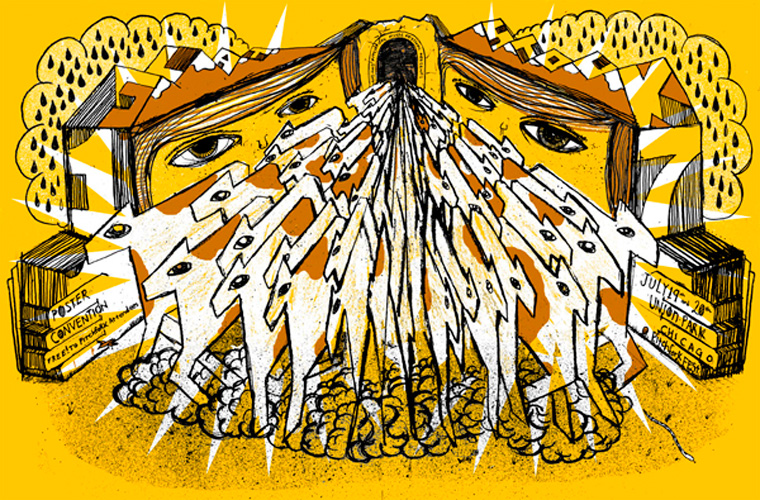Paul D’Elia, a Los Angeles-based screen-print poster artist, reviews work on Art4Punks.blogspot.com. “There is so much amazing visual eye candy out there in today’s fast-moving world,” he says. “My blog just seemed like a good way for me to pin down and focus in on what most impresses me.”
 Liza Rush
Liza Rush
Poster Art: Ryan Duggan’s punchy minimalism
Screen-printing poster artist Ryan Duggan grew up in Northern Illinois in a small town that Tom Waits wrote a song about. “There I spent all my time drawing and forming shitty bands with my friends,” he says. For reasons still unbeknownst to him, Duggan then relocated to Chicago to study advertising. Maps & Atlases was formed by friends shortly after, and Duggan has been screen-printing since.
“Many posters these days are meaningless collages made in Photoshop and distressed to look ‘rock and roll,’” he says. “It comes off looking very fake to me. I feel that music is a dirty, stupid ordeal and that this should come across in the imagery — it’s how you know everyone’s still having fun.”
Poster Art: Dan Grzeca’s paint-inspired screen prints
Fifteen years ago, Chicago artist Dan Grzeca (pronounced Jet-sah) was painting. It was the ’90s, and Bob Hartzell and Steve Walters of Screwball Press introduced him and a slew of other artists, including Jay Ryan, to screen printing — specifically, poster making. “That’s one of the reasons Chicago has such a rich pool of talent,” Grzeca says. “It’s very self-perpetuating with older artists inspiring and encouraging new, younger artists.”
Poster Art: Garrett Karol’s tactile style
Texture and muted color schemes create the gritty but expensive feel of Garrett Karol’s work. “I really like to print on cream paper and off-white paper too,” the Missouri-based designer says. “It looks nice.”
Whether intentional or not, Karol’s use of subdued color palettes paired with dark overlays has become his brand and can largely be attributed to his success.
Poster Art: Nels “Jagmo” Jacobson’s fortuitous relocation
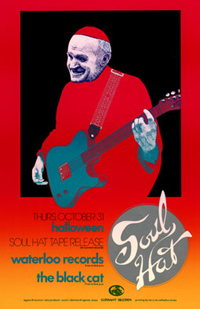 “It was a move to Austin, Texas in 1978 that touched off my fascination with poster art,” says Nels Jacobson, better known as psychedelic-poster artist Jagmo. “That move changed my life.”
“It was a move to Austin, Texas in 1978 that touched off my fascination with poster art,” says Nels Jacobson, better known as psychedelic-poster artist Jagmo. “That move changed my life.”
In Texas at Club Foot as a bar manager and promotions director, Jacobson was able to mingle with music legends such as B.B. King, James Brown, and Stevie Ray Vaughan and also artists that he commissioned for concert posters.
Poster Art: Cricket Press’ creative diversity
First working out of a tiny home studio in Lexington, Kentucky, Brian and Sara Turner created Cricket Press, a hand-printing, silk-screening, poster-making operation, in 2003. Since then, the duo has generated work for hundreds of bands, ranging from “indie rock to free jazz, bluegrass to punk, as well as promotional work for events both local and national,” the Turners say.
Poster Art: Joanna Wecht’s Womanly World
By using vintage images of women and by hand printing her own work because printing “tastes like ribs and chicken,” Joanna Wecht creates raw, multi-dimensional posters.
But she maintains that the imagery is not used to be an activist or prove a point; Wecht just enjoys being a “girl, a young lady, a woman,” and utilizes images that portray her disposition.
Poster Art: The Bubble Process
The Bubble Process was conceived 10 years ago in the back of a classroom and finally birthed in 2006 after graduation, relocation, and four years of “weirdness.”
Poster Art: Mara Piccione’s Anthropomorphism
![builttospill_af_drukgangen [Converted]](https://alarm-magazine.com/wp-content/uploads/2010/04/piccione3_small.jpg) Netherlands-based artist Mara Piccione explores love, childhood, nightmares, sadness, mental illness, and the “beauty of it all” in her silk-screened, music-centered work.
Netherlands-based artist Mara Piccione explores love, childhood, nightmares, sadness, mental illness, and the “beauty of it all” in her silk-screened, music-centered work.
In addition to her themes of of human/animal hybrids, this blend of features depicts expressions that “make is possible for a character to be sweet, sad, and weird at the same time.”
Zine Scene: Wordplay with Katie Haegele
Katie Haegele’s language-centric zines grew, quite appropriately, out of having something to say, but nowhere to say it.
Zine Scene: The Sociology of Aaron Lake Smith
Like countless other works of art, Aaron Lake Smith’s zines were born out of boredom. The author of Big Hands and Unemployment recalls how he got started in writing, in 2004: “I spent a summer living in a moldy garage behind an anarchist collective in Greensboro, North Carolina. All my friends were gone, and I had nothing else to do.”
Zine Scene: Independence and Creativity in Publishing
Zine Scene is a new weekly column where you can learn about new and established zinesters, as well as other people from inside the scene as they talk about their experiences in the unique and fascinating world of independently published media.

